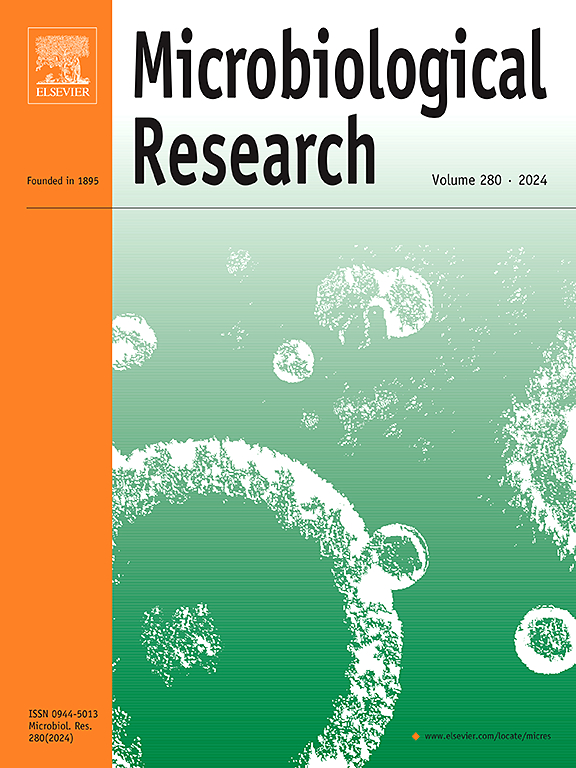Rhizosphere metabolite dynamics in continuous cropping of vineyards: Impact on microflora diversity and co-occurrence networks
IF 6.9
1区 生物学
Q1 MICROBIOLOGY
引用次数: 0
Abstract
The metabolism of the crop rhizosphere affects microflora diversity and nutrient cycling. However, understanding rhizosphere metabolism in suitable crops within arid desert environments and its impact on microflora interactions remains limited. Through metagenomic and non-targeted metabolomic sequencing of rhizosphere soils from one uncultivated land and four vineyards with cropping years of 5, 10, 15 and 20 years, the critical importance of rhizosphere metabolites in maintaining bacterial and fungal diversity was elucidated. The results revealed that Nocardioides, Streptomyces, and Solirubrobacter were the relatively abundant bacterial genera in rhizosphere soils, while Rhizophagus, Glomus, and Pseudogymnoascus were the relatively abundant fungal genera. The composition of rhizosphere metabolic changed significantly during the continuous cropping of grapevines. Dimethylglycine, Formononetin, and Dehydroepiandrosterone were the most important metabolites. Enrichment analysis revealed significant involvement of metabolic pathways such as biosynthesis of amino acids, unsaturated fatty acids, and linoleic acid metabolism. Procrustes analysis highlighted stronger correlations between rhizosphere metabolites and bacterial community compared to those of fungal community. This suggests distinct responses of microflora to crop-released chemical elements across different soil habitats. Co-occurrence network analysis demonstrated complex associations between rhizosphere metabolites and soil microflora, the positive correlations between rhizosphere metabolites and microflora networks predominated over negative correlations. Partial least squares path model indicated that the effect of cropping years on rhizosphere metabolites was greater than that on bacterial microflora diversity. Futhermore, pH, total phosphorus, and alkali-hydrolyzed nitrogen were the key environmental factors affecting rhizosphere metabolites and microbial diversity. These results deepen our valuable insights into the complex biological processes that rhizosphere metabolites influence on microorganisms, and provide strong support for maintaining microbial diversity in farmland soils in arid regions.
葡萄园连作的根际代谢物动态:对微生物群落多样性和共生网络的影响
作物根际代谢影响微生物区系多样性和养分循环。然而,对干旱沙漠环境下适宜作物根际代谢及其对微生物群相互作用的影响的了解仍然有限。通过对一块荒地和4个种植5、10、15和20年的葡萄园的根际土壤进行元基因组和非靶向代谢组测序,阐明了根际代谢物在维持细菌和真菌多样性中的重要作用。结果表明,根际土壤中Nocardioides、Streptomyces和Solirubrobacter是相对丰富的细菌属,而Rhizophagus、Glomus和Pseudogymnoascus是相对丰富的真菌属。葡萄连作期间根际代谢成分发生了显著变化。二甲基甘氨酸、芒柄花素和脱氢表雄酮是最重要的代谢物。富集分析揭示了氨基酸、不饱和脂肪酸和亚油酸代谢等代谢途径的显著参与。Procrustes分析显示根际代谢物与细菌群落的相关性强于真菌群落。这表明在不同的土壤生境中,微生物区系对作物释放的化学元素有不同的响应。共现网络分析表明,根际代谢物与土壤菌群之间存在复杂的相关关系,根际代谢物与土壤菌群之间的正相关大于负相关。偏最小二乘路径模型表明,种植年限对根际代谢物的影响大于对细菌菌群多样性的影响。pH、总磷和碱解氮是影响根际代谢物和微生物多样性的关键环境因子。这些结果加深了我们对根际代谢物影响微生物的复杂生物过程的有价值的认识,并为维持干旱地区农田土壤微生物多样性提供了强有力的支持。
本文章由计算机程序翻译,如有差异,请以英文原文为准。
求助全文
约1分钟内获得全文
求助全文
来源期刊

Microbiological research
生物-微生物学
CiteScore
10.90
自引率
6.00%
发文量
249
审稿时长
29 days
期刊介绍:
Microbiological Research is devoted to publishing reports on prokaryotic and eukaryotic microorganisms such as yeasts, fungi, bacteria, archaea, and protozoa. Research on interactions between pathogenic microorganisms and their environment or hosts are also covered.
 求助内容:
求助内容: 应助结果提醒方式:
应助结果提醒方式:


